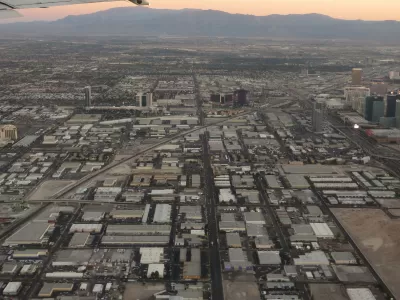New suburbs continue to expand into previously undeveloped areas, putting strain on local resources.

"Between 2001 and 2019, the built-up landscape of America — buildings, roads and other structures — has expanded into previously undeveloped areas, adding more than 14,000 square miles of new development across the contiguous United States," report Zach Levitt and Jess Eng.
"Suburbs are sprawling out in Arizona and Nevada as industries move to the Sun Belt, retirement communities are popping up in Florida as the baby boomer generation ages, and oil and natural gas wells have emerged across North Dakota and West Texas." Meanwhile, "[a]s cities on the coasts have become more and more expensive, there has been an influx of people and industries into other parts of the country, creating the perfect conditions for rapid sprawl into available land in the South and West." But recent growth has led to sharp increases in housing costs, too. "Across the country, housing prices have risen by almost 25 percent since March 2020, creating bidding wars for any house that goes on the market in cities like Boise." Reno's "median price for an existing single-family home has recently reached half a million dollars."
But this comes at a cost, write Levitt and Eng. "Researchers and experts have said explosive urban development was a contributing factor for the intense flooding after Hurricane Harvey devastated Houston in 2017," partly due to an increase in impervious surfaces that prevent floodwater from draining away. At the same time, cities in the Southwest struggle to maintain adequate water supplies for their fast-growing populations as reservoirs dwindle to historic lows.
FULL STORY: Where America’s developed areas are growing: ‘Way off into the horizon’

Alabama: Trump Terminates Settlements for Black Communities Harmed By Raw Sewage
Trump deemed the landmark civil rights agreement “illegal DEI and environmental justice policy.”

Planetizen Federal Action Tracker
A weekly monitor of how Trump’s orders and actions are impacting planners and planning in America.

Why Should We Subsidize Public Transportation?
Many public transit agencies face financial stress due to rising costs, declining fare revenue, and declining subsidies. Transit advocates must provide a strong business case for increasing public transit funding.

Understanding Road Diets
An explainer from Momentum highlights the advantages of reducing vehicle lanes in favor of more bike, transit, and pedestrian infrastructure.

New California Law Regulates Warehouse Pollution
A new law tightens building and emissions regulations for large distribution warehouses to mitigate air pollution and traffic in surrounding communities.

Phoenix Announces Opening Date for Light Rail Extension
The South Central extension will connect South Phoenix to downtown and other major hubs starting on June 7.
Urban Design for Planners 1: Software Tools
This six-course series explores essential urban design concepts using open source software and equips planners with the tools they need to participate fully in the urban design process.
Planning for Universal Design
Learn the tools for implementing Universal Design in planning regulations.
Caltrans
Smith Gee Studio
Institute for Housing and Urban Development Studies (IHS)
City of Grandview
Harvard GSD Executive Education
Toledo-Lucas County Plan Commissions
Salt Lake City
NYU Wagner Graduate School of Public Service





























